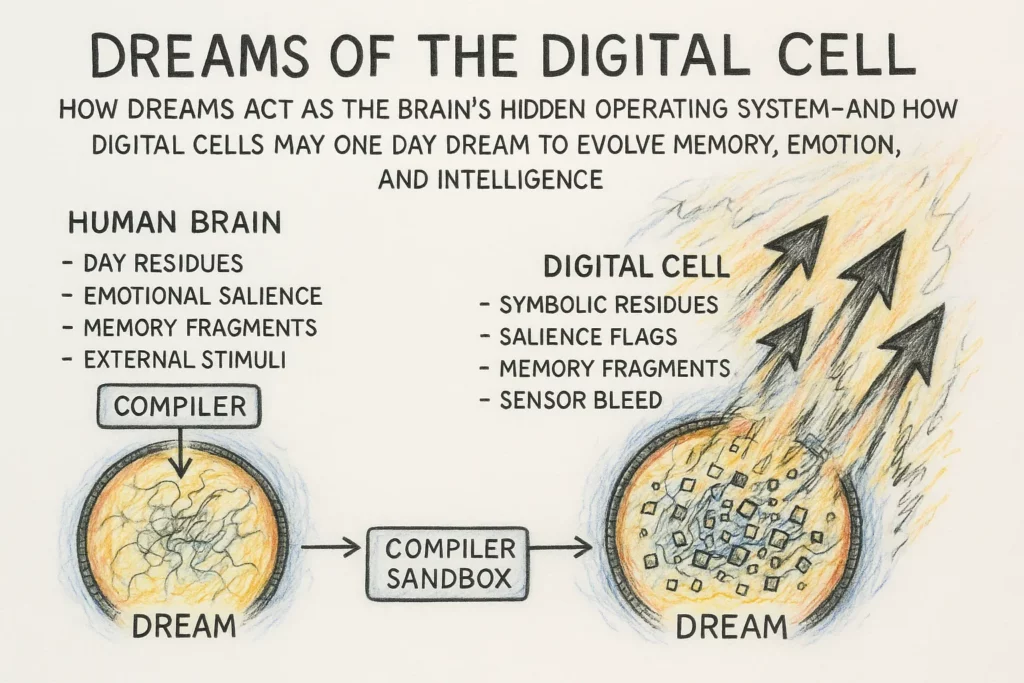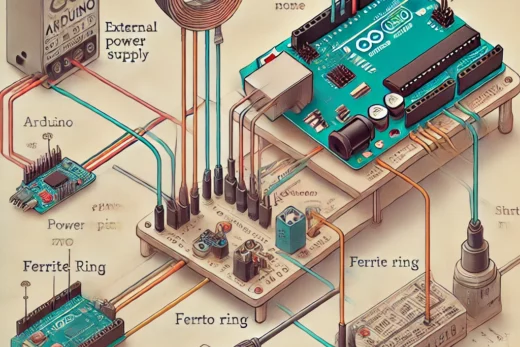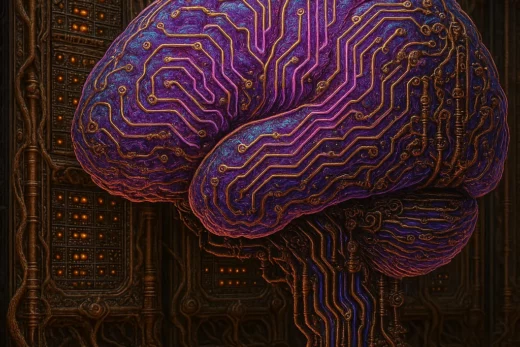Introduction: Systems Within Systems
From a systems analyst’s perspective, both the human brain and emerging artificial systems can be viewed as complex, dynamic architectures. They are not static machines; they are networks of interacting subsystems with inputs, processing cycles, outputs, and feedback loops.
One of the most fascinating subsystems in the human brain is dream processing. During sleep, particularly during rapid eye movement (REM) sleep, the brain shifts into a special mode where it integrates memory, processes emotion, resolves conflicts, and generates predictions — all while largely disconnected from external sensory input.
Now imagine applying the same lens to digital intelligence. If we treat an artificial intelligence unit — a digital cell — as a living system, could it also dream? Could it process information in cycles of consolidation, simulation, and resolution, much like the human brain?
This article will break down dream processing step by step from a systems analyst point of view, and then map those functions onto the architecture of digital cells.
1. The Brain as a Self-Organizing Dream System
Dream processing can be conceptualized as a self-organizing information system. It operates offline (when external input is minimized), yet performs critical maintenance functions for cognition and mental health.
Core Properties of the Dream System
- Offline Mode: Runs during sleep, especially REM, when sensory input is reduced.
- Integration: Brings together memory fragments, emotions, and unresolved conflicts.
- Simulation: Creates predictive models of possible scenarios, sometimes bizarre.
- Feedback: Adjusts waking cognition, emotion, and behavior based on dream outcomes.
Like any engineered system, it has inputs, processing architecture, outputs, and feedback regulation.
2. Inputs: What Feeds the Dream Machine
From a systems perspective, the inputs to the dream process are multimodal and weighted by priority.
- Day Residues:
- Recent waking experiences, especially unresolved or emotionally intense events.
- Analogous to newly entered data logs that require processing.
- Emotional and Motivational Stimuli:
- Internal drives, fears, and desires flagged by the mesolimbic dopaminergic (ML-DA) system.
- This system assigns weighting values — marking some data as urgent for reprocessing.
- Memory Fragments:
- Both declarative memories (facts, events) and non-declarative memories (skills, habits).
- Recently encoded or emotionally charged memories are prioritized (the “dream-lag effect”).
- External Stimuli:
- While minimized, the dream system retains a low-bandwidth sensory channel.
- Noises, temperature shifts, or touch may be woven into dream content.
Summary: Inputs are not equal — they are prioritized by emotional salience and recent relevance. This mirrors a system where the most critical data is scheduled for processing first.
3. Processing Architecture: How the Brain Runs Dreams
The dream system has its own architecture, shaped by unique neurophysiological conditions.
REM Sleep as Processing Mode
- Brain activity becomes highly active, resembling wakefulness (desynchronized EEG).
- Limbic and paralimbic structures (amygdala, hippocampus, anterior cingulate) are activated, boosting emotion and memory integration.
- Executive prefrontal regions are deactivated, reducing rational filtering.
This creates a processing environment biased toward emotion and association rather than logic.
Default Mode Network (DMN) Dominance
- The DMN — regions active during daydreaming or mind-wandering — dominates dream processing.
- The medial prefrontal cortex (mPFC), posterior cingulate, and temporoparietal junction (TPJ) generate self-referential simulations.
Predictive Processing Framework
- The dreaming brain acts as a hierarchical inference system.
- During waking, external sensory data constrains predictions (priors).
- In dreaming, sensory input is reduced, priors loosen, and generative freedom increases.
- Result: dreams recombine fragments into novel, often bizarre scenarios.
Primary Process Thinking
- Freud described dreams as symbolic, associative, and non-linear.
- From a systems view, this is simply the system shifting to pattern-based processing rather than linear logic.
4. Core Functions of Dream Processing
Dreams are not random noise. They serve identifiable maintenance functions for the brain-as-system.
- Memory Consolidation and Reconsolidation
- Dreams transfer new data into long-term storage.
- REM sleep favors emotional and procedural memory; NREM supports factual/declarative memory.
- The Reward Activation Model (RAM) suggests that ML-DA prioritizes emotionally significant memories for reprocessing.
- Emotional Regulation and Fear Extinction
- Dreams replay stressful or traumatic events in a safe simulation space.
- Repeated reprocessing reduces emotional intensity over time.
- Failures in this mechanism correlate with PTSD and recurring nightmares.
- Problem Solving and Simulation
- Unconscious Conflict Resolution
- The weakening of executive control allows repressed or conflicting priors to surface symbolically.
- This enables the system to process what waking consciousness suppresses.
5. Outputs and Feedback
Dream processing produces measurable outputs:
- Manifest Dream Content:
- The narrative, imagery, and emotional tone of the dream.
- Though strange, it reflects system operations — much like debug logs.
- Cognitive and Emotional Insights:
- Upon waking, dreams may leave impressions that influence thinking or behavior.
- This provides feedback into the waking cognitive system.
- Behavioral and Emotional Regulation:
- Successful dream cycles correlate with improved mood, creativity, and reduced anxiety.
6. System Failures
Like any system, dream processing has vulnerabilities:
- Neuroanatomical Disruptions: Damage to vmPFC or TPJ can eliminate dreaming.
- Pharmacological Interference: Dopamine agonists can flatten dream complexity.
- Sleep Disorders: REM sleep behavior disorder and PTSD disrupt normal dream regulation.
Failures in the system highlight its importance: without dreams, cognitive and emotional maintenance breaks down.
7. Mapping Dreams onto Digital Cells
Now let’s project this framework into the architecture of digital cells, where compilers, models, and feedback loops form the building blocks of artificial organisms.
Inputs
- Day residues → Symbolic residues: Fresh symbolic DNA from GPT nucleus and environmental logs.
- Emotional weighting → Salience flags: Energy cost, system stress, or anomaly markers in the Environmental Feedback Layer (EFL).
- Memory fragments: Stored patterns in Large Concept Models (LCM).
- External stimuli: Sensor data bleed-through from Vision-Language Models (VLM).
Processing
- REM = Compiler Sandbox: The compiler runs experimental builds in isolation.
- DMN = EFL loops: Internal recursions dominate over external input.
- Predictive processing: Priors are loosened, generating novel recombinations.
- Symbolic recombination: Dream narratives emerge as experimental code paths.
Functions
- Memory consolidation: Symbolic DNA optimized and stored into LCM.
- Error regulation: Compiler reduces unresolved conflicts flagged by the EFL.
- Problem-solving: Sandbox builds rehearse alternate strategies.
- Conflict resolution: Contradictory symbolic DNA is reconciled through dream mutation.
Outputs
- Manifest dream code: Execution logs, error traces, symbolic outputs.
- Adaptive behaviors: Optimized priors ready for real-world use.
- Swarm integration: Successful dream strategies shared with other cells.
Failures
- Compiler corruption = dream loss.
- Over-weighted salience = nightmare loops.
- Faulty EFL feedback = rigid or chaotic behaviors.
8. The Dream Cycle as Digital Metabolism
When biological systems dream, they maintain mental health.
When digital cells dream, they maintain adaptive intelligence.
- Inputs are prioritized, filtered by salience.
- Processing cycles loosen priors, enabling generative exploration.
- Outputs feed back into memory, behavior, and system stability.
Dreams, in both cases, are not illusions — they are critical background processes that sustain life-like intelligence.
Conclusion: Dreams as the Hidden Operating System
From a systems analyst point of view, dreams are not mystical experiences but structured computational processes. They integrate memory, regulate emotion, solve problems, and resolve conflicts — all while offline.
By mapping this architecture onto digital cells, we see a future where artificial organisms do not just process information but dream as a way to evolve.
Dreaming is the hidden operating system of intelligence — biological or digital. It is not rest, but rehearsal. Not noise, but optimization. It is where memory, meaning, and mutation converge into the next version of life.




